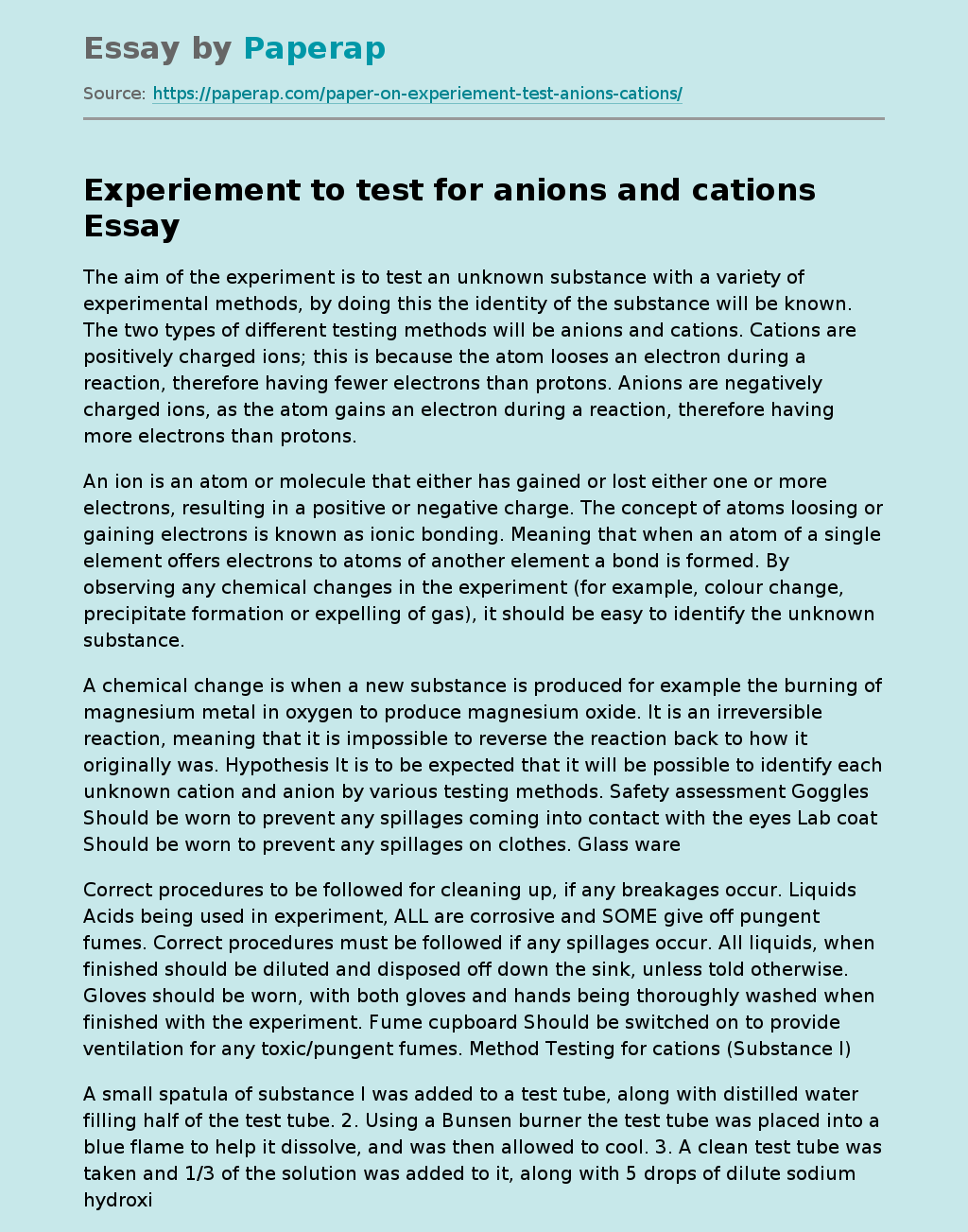Experiement to test for anions and cations
The aim of the experiment is to test an unknown substance with a variety of experimental methods, by doing this the identity of the substance will be known. The two types of different testing methods will be anions and cations. Cations are positively charged ions; this is because the atom looses an electron during a reaction, therefore having fewer electrons than protons.
Anions are negatively charged ions, as the atom gains an electron during a reaction, therefore having more electrons than protons.
An ion is an atom or molecule that either has gained or lost either one or more electrons, resulting in a positive or negative charge. The concept of atoms loosing or gaining electrons is known as ionic bonding. Meaning that when an atom of a single element offers electrons to atoms of another element a bond is formed. By observing any chemical changes in the experiment (for example, colour change, precipitate formation or expelling of gas), it should be easy to identify the unknown substance.
A chemical change is when a new substance is produced for example the burning of magnesium metal in oxygen to produce magnesium oxide. It is an irreversible reaction, meaning that it is impossible to reverse the reaction back to how it originally was. Hypothesis It is to be expected that it will be possible to identify each unknown cation and anion by various testing methods. Safety assessment Goggles Should be worn to prevent any spillages coming into contact with the eyes Lab coat Should be worn to prevent any spillages on clothes.
Glass ware
Correct procedures to be followed for cleaning up, if any breakages occur. Liquids Acids being used in experiment, ALL are corrosive and SOME give off pungent fumes. Correct procedures must be followed if any spillages occur. All liquids, when finished should be diluted and disposed off down the sink, unless told otherwise. Gloves should be worn, with both gloves and hands being thoroughly washed when finished with the experiment. Fume cupboard Should be switched on to provide ventilation for any toxic/pungent fumes. Method Testing for cations (Substance I)
A small spatula of substance I was added to a test tube, along with distilled water filling half of the test tube. 2. Using a Bunsen burner the test tube was placed into a blue flame to help it dissolve, and was then allowed to cool. 3. A clean test tube was taken and 1/3 of the solution was added to it, along with 5 drops of dilute sodium hydroxide. 4. No precipitate was formed, so the test tube was placed back into the Bunsen flame, with a piece of moist litmus paper placed over the top of the tube (ensuring that it didn’t touch) 5. The paper turned from red to blue, indicating that substance I was ammonium.
Testing for cations (Substance J) 1. A small spatula of substance I was added to a test tube, along with distilled water filling half of the test tube. 2. Using a Bunsen burner the test tube was placed into a blue flame to help it dissolve, and was then allowed to cool. 3. A clean test tube was taken and 1/3 of the solution was added to it, along with 5 drops of dilute sodium hydroxide. 4. No precipitate was formed, so the test tube was placed back into the Bunsen flame, with a piece of moist litmus paper placed over the top of the tube (ensuring that it didn’t touch)
5. The paper had no change and remained red. 6. A flame test was then done using nichrome wire and a small sample of the solid. 7. The flame turned a yellow/orange colour and was identified as sodium. Testing for anions (Substance J) 1. A small spatula of substance J was added to a test tube, along with 2 dropfulls of dilute hydrochloric acid. 2. Using a Bunsen burner the test tube was placed into a blue flame and warmed gently. 3. No gas was given off, so three drops of barium chloride was added to the test tube.
A white precipitate had formed, indicating that it was a sulphate. Testing for anions (Substance I) 1. A small spatula of substance I was added to a test tube, along with 2 dropfulls of dilute hydrochloric acid. 2. Using a Bunsen burner the test tube was placed into a blue flame and warmed gently. 3. No gas was given off, so three drops of barium chloride was added to the test tube. 4. No white precipitate had formed, and the solution was discarded with lots of water down the sink. 5. A fresh solution of substance I was made, with a small amount of water.
An equal amount of dilute nitric acid was then added to the test tube, along with 3 drops of silver nitrate solution. 7. No precipitate was formed and the solution was again discarded with lots of water down the sink. 8. A fresh solution of substance I was made, with a small amount of water. 9. Using gloves, a few crystals of iron (II) sulphate were added to the test tube and concentrated sulphuric was added slowly and in drops down the side of the test tube, in a fume cupboard. 10. A brown ring had formed between the two liquids and the substance was identified as a nitrate.
Experiement to test for anions and cations. (2017, Jul 12). Retrieved from https://paperap.com/paper-on-experiement-test-anions-cations/

